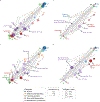Early prediction of mortality and morbidities in VLBW preterm neonates using machine learning
- PMID: 39379627
- PMCID: PMC12249422
- DOI: 10.1038/s41390-024-03604-7
Early prediction of mortality and morbidities in VLBW preterm neonates using machine learning
Abstract
Background: Predicting mortality and specific morbidities before they occur may allow for interventions that may improve health trajectories.
Hypothesis: Integrating key maternal and postnatal infant variables in the first 2 weeks of age into machine learning (ML) algorithms will reliably predict survival and specific morbidities in VLBW preterm infants.
Methods: ML algorithms were developed to integrate 47 features for predicting mortality, bronchopulmonary dysplasia (BPD), neonatal sepsis, necrotizing enterocolitis (NEC), intraventricular hemorrhage (IVH), cystic periventricular leukomalacia (PVL), and retinopathy of prematurity (ROP). A retrospective cohort (n = 3341) was used to train and validate the models with a repeated 10-fold cross-validation strategy. These models were then tested on a separate cohort (n = 447) to evaluate the final model performance.
Results: Among the seven ML algorithms employed, tree-based ensemble models, specifically Random Forest (RF) and XGBoost, had the best performance metrics. The area under the receiver operating characteristic curve (AUROC) of sepsis with or without meningitis (0.73), NEC (0.73), BPD (0.71), and mortality (0.74) exceeded 0.7, while the area under Precision-Recall curve (AUPRC) for all outcomes was greater than the prevalence, demonstrating effective risk stratification in VLBW preterm infants.
Conclusions: Our study demonstrates the potential of predictive analytics leveraging ML techniques in advancing precision medicine.
Impact: Reliable prediction of adverse outcomes before they occur has the potential to institute interventions and possibly improve health trajectories in VLBW preterm infants. We used machine learning to develop and test predictive models for mortality and five major morbidities in VLBW preterm infants. Individualized prediction of outcomes and individualized interventions will advance Precision Medicine in Neonatology.
© 2024. The Author(s), under exclusive licence to the International Pediatric Research Foundation, Inc.
Conflict of interest statement
Competing interests: The authors declare no competing interests.
Figures




References
-
- Preterm Birth: Causes, Consequences, and Prevention (National Academies Press, 2007). - PubMed
-
- in Centers for Disease Control and Prevention (2023).
MeSH terms
Grants and funding
LinkOut - more resources
Full Text Sources
Medical

